|
|
|||
|
(Back to Preceding Week; on to Next Week) |
|
LATE MAY SNAPSHOT
Even though we've lived at Hilton Pond Center for more than a quarter century, scarcely a day goes by we don't find something new--or see something old in a new way. We're constantly amazed and entertained and enlightened by natural occurrences that continually unfold before our eyes on the little 11-acre plot where we're fortunate to live and work. This week we'd like to share a few observations made over the past ten days--a "late May snapshot" that helps chronicle the passage between spring and summer in the Carolina Piedmont.
All text & photos © Hilton Pond Center Growing at several spots along the trails at Hilton Pond Center are spindly shrubs with stems green all the way to the ground. At this time of year, the upper portions of these stems bear inch-long, lightly serrated leaves; arising from the bases of the leaf petioles are hairlike structures that end in unusually shaped whitish five-part flowers about a quarter-inch across (above). We recognize the shrub as the native Strawberry-bush, Euonymus americana, a relative of the invasive and over-used landscape plant Winged Euonymus, E. alatus, AKA Burning Bush.
One thing that happens at least weekly--sometimes daily--at Hilton Pond Center but of which we never tire is the appearance of an old friend we've been watching for years. Usually in early afternoon we're distracted from our computer work by movement near our office window. About five feet out from the glass grows a tall, slender Flowering Dogwood, whose rough trunk with squarish chunks of bark provides a perfect climbing surface for arboreal serpents. In particular, the tree appears to be a favorite haunt of a four-foot Black Ratsnake, Elaphe obsoleta, that approaches the dogwood at ground level and moves upward by combination of movements that include twining around the tree and temporarily wedging itself in bark fissures. By the time the snake gets seven feet up the trunk it is at desktop level and about where we typically notice its presence. That's also the height at which the dogwood begins to branch, providing a spot where the snake can pause for a moment after the vertical climb. During its rest stop, we sometimes see the ratsnake's belly is distended so much the skin between the scales is stretched and exposed--a sure sign the snake downed an Eastern Chipmunk or Cotton Rat before starting its ascent.
Our beneficial Black Ratsnake wouldn't hesitate a second to engulf any small mammal it encounters along the trails at Hilton Pond Center. This includes the Woodland (Pine) Vole, Microtus pinetorum (above), a species we seldom see--even though we know it's present year-round. Our usual encounter with this four-inch long, stub-tailed rodent comes when we detect movement beneath leaves on the ground under our bird feeders. If we're quick we can scoop up a handful of leaf litter AND a vole before it escapes with a mouthful of sunflower seeds.
The view above eliminated any doubts one might have about the butterfly's identification: It was definitely a Mourning Cloak, Nymphalis antiopa, and one of the brush-footed butterflies (Nymphalidae)--so called because their front legs are quite small and brushlike. The undersides of Mourning Cloak wings are a wrinkled-looking brownish-black, with yellow or yellow-white edging. Dorsally, colors are much brighter, including a row of metallic blue spots that continues from forewing to hindwing. Members of this species overwinter as adults, emerging in spring to mate. The egg hatches into a bristly, jet-black caterpillar with a row of red spots down its back. The larva's favorite foods include, among others, willows (Salix spp.) and Hackberry (Celtis occidentalis). Adults eat tree sap, especially from oaks (Quercus spp.), which they locate by walking down a trunk head first (above) until encountering sap seeping from a crack in the bark. Adults may live 10-11 months--perhaps the longest life span for any North American butterfly.
For the past few weeks we've been hearing loud noises emanating from trees at various spots around Hilton Pond Center. Although the trees weren't necessarily near the pond itself, we knew the sounds to be frog calls--specifically Gray Treefrogs, an animal on the increase locally as our property has changed from farmland to woodland. There are two species--Hyla chrysoscelis and H. versicolor--but herpetologists seem to disagree on whether both occur in both Carolinas. They are indistinguishable except by call or genetic analysis, and some experts say H. versicolor has not been satisfactorily documented in the Palmetto State. Our aging ears can no longer tell if frog calls have 45 trills per second (H. chrysoscelis) or only 25 (H. versicolor), and for some reason our eyes just aren't good enough to see that each cell of H. versicolor has 48 chromosomes--twice as many as those of its congener. Unless you hunt them down when they're calling, Gray Treefrogs are usually encountered near porch lights at night or by day when you happen to find one huddled up in a resting place. Normally, that spot would be the gray bark of a tree trunk or limb; such a site--especially if it's peppered with lichens--is a perfect place for an appropriately camouflaged Gray Treefrog to hide.
The American Goldfinch wasn't the only yellow bird we spotted this week at Hilton Pond Center. In fact, because we were running mist nets we got a special treat: The opportunity to handle and photograph a male Canada Warbler, Wilsonia canadensis (above). This was special for several reasons, not the least of which was that it was only the 32nd of its species we've banded at the Center since 1982, the first since 2006, and only the sixth in the past ten years. We catch few of this species primarily because we're in the center of the Piedmont Region--not exactly a major migratory path for warblers; as a result, we typically get fewer Neotropical migrants than coastal and mountain areas. This particular Canada Warbler was also special because it was a male in full breeding attire: A bright yellow breast marked with a dark black necklace. (Most of our captures are drabber-colored fall juveniles or females, at right, with pale necklaces. Our bird was also a bit tardy; we caught it on 23 May and the published late date for a migrant Canada Warbler in South Carolina is 26 May. The bird undoubtedly was on its way to nesting grounds in Canada or the U.S. northern tier, although the species breeds rarely down the Appalachians as far south as north Georgia. The Canada Warbler is not really abundant anywhere and has shown about a 2% decline each year for the past four decades--meaning we're even less likely to catch one around Hilton Pond in the future.
So that's our "snapshot" of what's been going on at Hilton Pond Center in late May 2008. A blooming bush, a tree-climbing snake, a crawly critter that kills trees, a sap-drinking butterfly, an out-of-place treefrog, and a late Neotropical migrant bird. In this transition time between spring and summer, natural happenings are everywhere you look.
All text & photos © Hilton Pond Center
Comments or questions about this week's installment?
Thanks to the following fine folks for recent gifts in support of Hilton Pond Center for Piedmont Natural History and/or Operation RubyThroat: The Hummingbird Project. Your tax-deductible contributions allow us to continue writing, photographing, and sharing "This Week at Hilton Pond." (Please see Support if you'd like to make a gift of your own.)
"This Week at Hilton Pond" is written & photographed You may wish to consult our Index of all nature topics covered since February 2000. You can also use our on-line Hilton Pond Search Engine at the bottom of this page. For a free, non-fattening, on-line subscription to |
|
Make direct donations on-line via
Network for Good: |
|
|
Use your PayPal account
to make direct donations: |
|
|
If you like to shop on-line, you please become a member of iGive, through which more than 700 on-line stores from Barnes & Noble to Lands' End will donate a percentage of your purchase price in support of Hilton Pond Center and Operation RubyThroat. For every new member who signs up and makes an on-line purchase iGive will donate an ADDITIONAL $5 to the Center. Please sign up by going to the iGive Web site; more than 150 members have signed up to help. It's a painless, important way for YOU to support our work in conservation, education, and research. |
|
| The highly coveted Operation RubyThroat T-shirt (four-color silk-screened) is made of top-quality 100% white cotton. It highlights the Operation RubyThroat logo on the front and the project's Web address (www.rubythroat.org) across the back.
Now you can wear this unique shirt AND help support Operation RubyThroat: The Hummingbird Project and Hilton Pond Center. Be sure to let us know your mailing address and adult shirt size: Small (suitable for children), Medium, Large, X-Large, or XX-Large. These quality shirts don't shrink! Price ($21.50) includes U.S. shipping. A major gift of $1,000 gets you two Special Edition T-shirts with "Major Donor" on the sleeve. |

Need a Special Gift for a Want to make a If so, why not use our new handy-dandy on-line Google Checkout below to place your secure credit card order or become a Major Donor today? |
|
|
|
|
SPECIES BANDED THIS WEEK: * = New species for 2008 WEEKLY BANDING TOTAL 15 species 28 individuals YEARLY BANDING TOTAL (2008) 39 species 899 individuals 27-YEAR BANDING GRAND TOTAL (since 28 June 1982) 124 species 51,066 individuals NOTABLE RECAPTURES THIS WEEK (with original banding date, sex, and current age) Ruby-throated Hummingbird (1) Carolina Chickadee (2) American Goldfinch (1) Chipping Sparrow (1) Northern Cardinal (1) Carolina Wren (2)
|
OTHER NATURE NOTES OF INTEREST
--As mentioned last week, we hosted Ian Sinclair, South African birder extraordinaire, at Hilton Pond prior to taking him to the Mountain Lake Migratory Bird Festival in Virginia. Upon his eventual return home to Cape Town--and after last week's photo essay was originally posted--Ian sent a snapshot of himself decked out in his spiffy new Operation RubyThroat T-shirt (above). THAT should get some attention for the project on his next foray into Madagascar or the Antarctic. (NOTE: You can get your own Operation RubyThroat shirt and help support the work of Hilton Pond Center. Just scroll up a bit on this page and click on the order form. The shirts don't shrink and are perfect for hot-weather outdoor wear. Adult smalls and mediums are just right for kids.)
|
|
|
|
(Back to Preceding Week; on to Next Week) Up to Top of Page Back to This Week at Hilton Pond Center Current Weather Conditions at Hilton Pond Center |
 You can also post questions for The Piedmont Naturalist |
Join the |
Search Engine for |
|
|
OrientalTrading.com


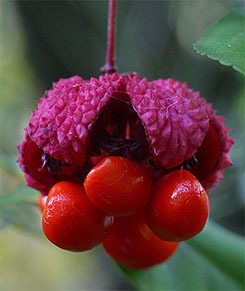 A decade ago, when Center property was in its "shrub period" of vegetational succession, we had quite a few mature Strawberry-bushes that annually produced the brilliant capsule and seeds that give the plant its common name (see Hilton Pond file photo at right). Now that we're in the "young woodland period" level of succession we have pines and hardwood trees sprouting into the canopy, whence they cast so much shade the Strawberry-bushes have gotten more spindly and less productive. To make matters worse, our ever-larger numbers of White-tailed Deer appear to prefer leaves and fresh twigs of these shrubs, which means anymore the flowers seldom survive to produce fruit. We consider this to be a real loss, if only because the Strawberry-bush fruits provide such a technicolor touch as they ripen in late summer. Incidentally, in England several members of the Euonymus group are called "spindle-trees," a reference to days when wood from these shrubs was used to make spindles for wool-spinning.
A decade ago, when Center property was in its "shrub period" of vegetational succession, we had quite a few mature Strawberry-bushes that annually produced the brilliant capsule and seeds that give the plant its common name (see Hilton Pond file photo at right). Now that we're in the "young woodland period" level of succession we have pines and hardwood trees sprouting into the canopy, whence they cast so much shade the Strawberry-bushes have gotten more spindly and less productive. To make matters worse, our ever-larger numbers of White-tailed Deer appear to prefer leaves and fresh twigs of these shrubs, which means anymore the flowers seldom survive to produce fruit. We consider this to be a real loss, if only because the Strawberry-bush fruits provide such a technicolor touch as they ripen in late summer. Incidentally, in England several members of the Euonymus group are called "spindle-trees," a reference to days when wood from these shrubs was used to make spindles for wool-spinning. 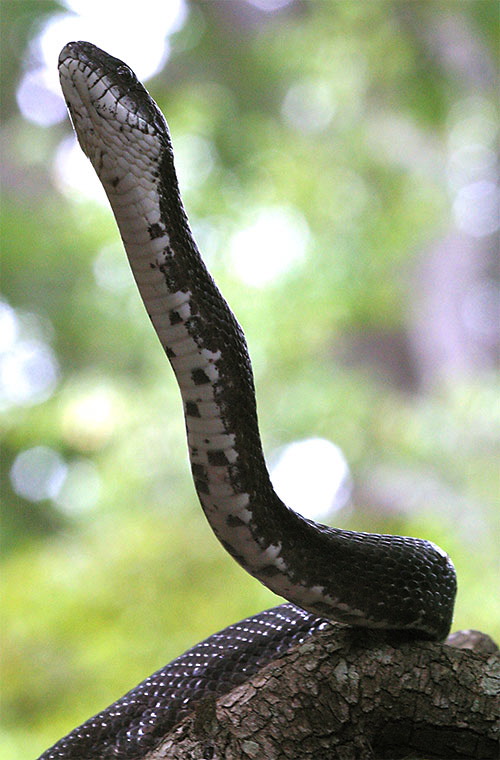
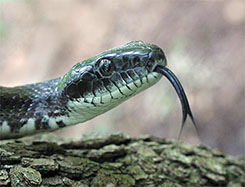 With tongue flickering to pick up traces of odor from the air (left), the ratsnake eventually extends its prehensile body--revealing a distinctive white chin and throat--and crawls further up the tree (above). As it reaches the end of a branch it disembarks its natural perch to crawl onto the roof above our office; from there the snake slithers along a gutter overhang to a two-inch hole--inaccessible to humans but a perfect serpent entry way to the attic of the old farmhouse. Once inside the snake prowls the joists and rafters in pursuit of White-footed Mice with which we unavoidably share our abode--and which we're happy to offer the Black Ratsnake in return for its vermin-removal services. What we've never figured out is where or when the snake leaves the attic after extermination work is done.
With tongue flickering to pick up traces of odor from the air (left), the ratsnake eventually extends its prehensile body--revealing a distinctive white chin and throat--and crawls further up the tree (above). As it reaches the end of a branch it disembarks its natural perch to crawl onto the roof above our office; from there the snake slithers along a gutter overhang to a two-inch hole--inaccessible to humans but a perfect serpent entry way to the attic of the old farmhouse. Once inside the snake prowls the joists and rafters in pursuit of White-footed Mice with which we unavoidably share our abode--and which we're happy to offer the Black Ratsnake in return for its vermin-removal services. What we've never figured out is where or when the snake leaves the attic after extermination work is done.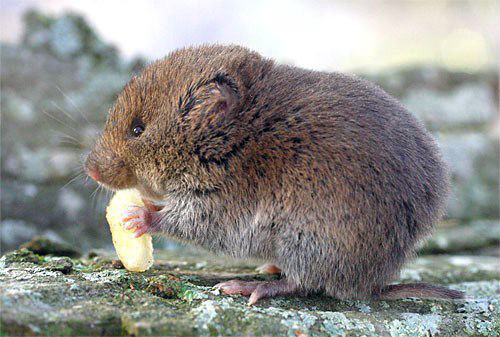
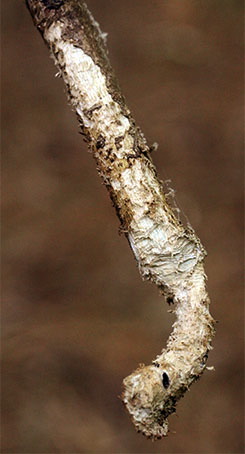 We haven't seen any voles lately but were reminded of their presence this week as we walked a trail that winds--appropriately enough--among a relatively new grove of Loblolly Pines, Pinus taeda. The ground beneath those trees is covered with dead needles and very little else, mostly because pine needles are so rot-resistant and acidic not much can grow until they finally start to decompose. Although we suppose there were little Pine Voles scurrying around under this bed of needles, we didn't stop to look for telltale movement. Instead we were distracted and perplexed by the condition of a couple of four-foot-tall saplings of American Holly, Ilex opaca, that after being quite healthy a few weeks ago were now tilted over and covered with shriveled, blackened leaves. We thought it odd these two hollies had died so suddenly until we pulled one of them upright and felt it snap off at ground level. At that moment we knew the cause of death: Stealthy Pine Voles had been gnawing undercover at the bases of the hollies and had completely girdled their half-inch-diameter trunks, cutting off flow of water, nutrients, and food and leaving behind tiny tell-tale tooth marks (above right). To be honest, we're not happy to lose two sapling American Hollies--we really like this species--but Pine Voles gotta live, too; thus, we won't intercede with this natural occurrence by putting out traps or poison. (We might try to hire a few more blacksnakes, however.)
We haven't seen any voles lately but were reminded of their presence this week as we walked a trail that winds--appropriately enough--among a relatively new grove of Loblolly Pines, Pinus taeda. The ground beneath those trees is covered with dead needles and very little else, mostly because pine needles are so rot-resistant and acidic not much can grow until they finally start to decompose. Although we suppose there were little Pine Voles scurrying around under this bed of needles, we didn't stop to look for telltale movement. Instead we were distracted and perplexed by the condition of a couple of four-foot-tall saplings of American Holly, Ilex opaca, that after being quite healthy a few weeks ago were now tilted over and covered with shriveled, blackened leaves. We thought it odd these two hollies had died so suddenly until we pulled one of them upright and felt it snap off at ground level. At that moment we knew the cause of death: Stealthy Pine Voles had been gnawing undercover at the bases of the hollies and had completely girdled their half-inch-diameter trunks, cutting off flow of water, nutrients, and food and leaving behind tiny tell-tale tooth marks (above right). To be honest, we're not happy to lose two sapling American Hollies--we really like this species--but Pine Voles gotta live, too; thus, we won't intercede with this natural occurrence by putting out traps or poison. (We might try to hire a few more blacksnakes, however.) At least one good-sized dark butterfly had been flitting around Hilton Pond Center during the last half of May. Somewhat smaller than the familiar Black Swallowtail, it always landed too high in vegetation for a photograph or moved away as we approached at eye level with our camera. Once we were able to fire off an unfulfilling telephoto exposure (above left) as the butterfly spread its wings on a expanse of bare soil near the pond, but finally--just in time for this essay--the insect landed on a tree trunk low enough for us to take a few more telephoto shots.
At least one good-sized dark butterfly had been flitting around Hilton Pond Center during the last half of May. Somewhat smaller than the familiar Black Swallowtail, it always landed too high in vegetation for a photograph or moved away as we approached at eye level with our camera. Once we were able to fire off an unfulfilling telephoto exposure (above left) as the butterfly spread its wings on a expanse of bare soil near the pond, but finally--just in time for this essay--the insect landed on a tree trunk low enough for us to take a few more telephoto shots.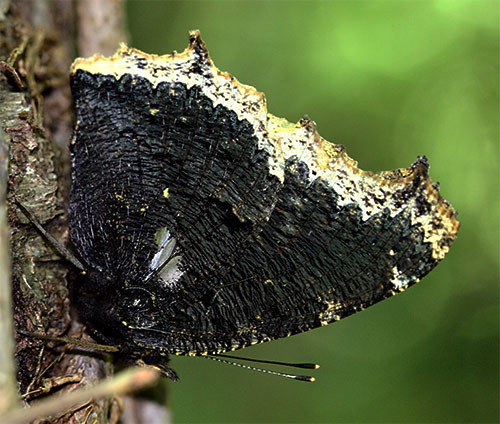
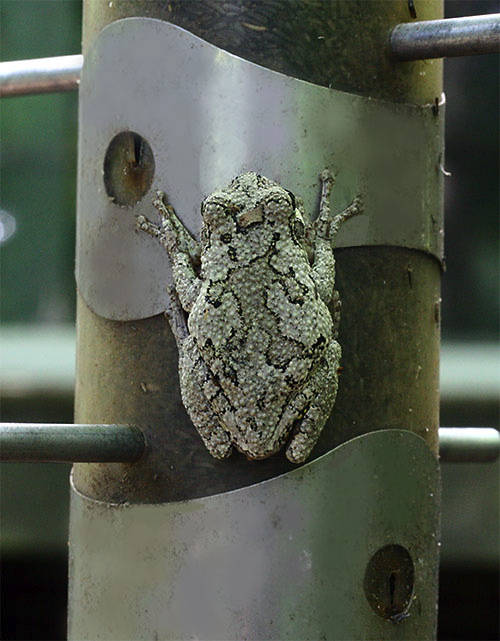
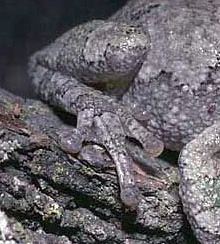 The one we found this week, however, was anything but inconspicuous; although motionless, it stood out like a sore thumb one morning as it clung to the side of a plastic thistle seed feeder (above) in the Center's backyard, using its treefrog toepads (left) to hold on. We're certain the frog wasn't after thistle, and there wouldn't have been enough insect prey around the feeder for a visit to be worthwhile. Thus, we're guessing the frog simply mistook the contraption for a tree trunk and settled down to rest before going on its next nighttime patrol. We photographed the oddly situated Gray Treefrog in morning light and noticed a few hours later the amphibian had been displaced by a trio of American Goldfinches, Carduelis tristis, that undoubtedly made far better use of thistle seeds.
The one we found this week, however, was anything but inconspicuous; although motionless, it stood out like a sore thumb one morning as it clung to the side of a plastic thistle seed feeder (above) in the Center's backyard, using its treefrog toepads (left) to hold on. We're certain the frog wasn't after thistle, and there wouldn't have been enough insect prey around the feeder for a visit to be worthwhile. Thus, we're guessing the frog simply mistook the contraption for a tree trunk and settled down to rest before going on its next nighttime patrol. We photographed the oddly situated Gray Treefrog in morning light and noticed a few hours later the amphibian had been displaced by a trio of American Goldfinches, Carduelis tristis, that undoubtedly made far better use of thistle seeds.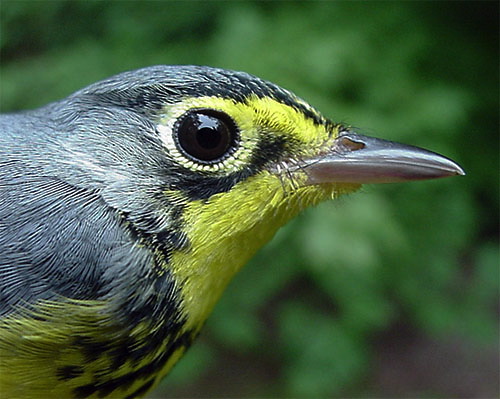
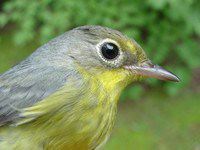 In any plumage, this species' combination of yellow underparts, gray upper, and absence of wingbars and tail spots is unique among warblers.)
In any plumage, this species' combination of yellow underparts, gray upper, and absence of wingbars and tail spots is unique among warblers.)

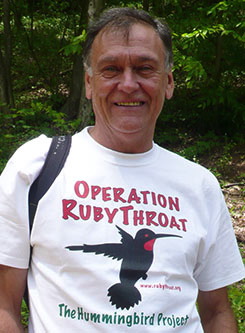
 Please report your
Please report your